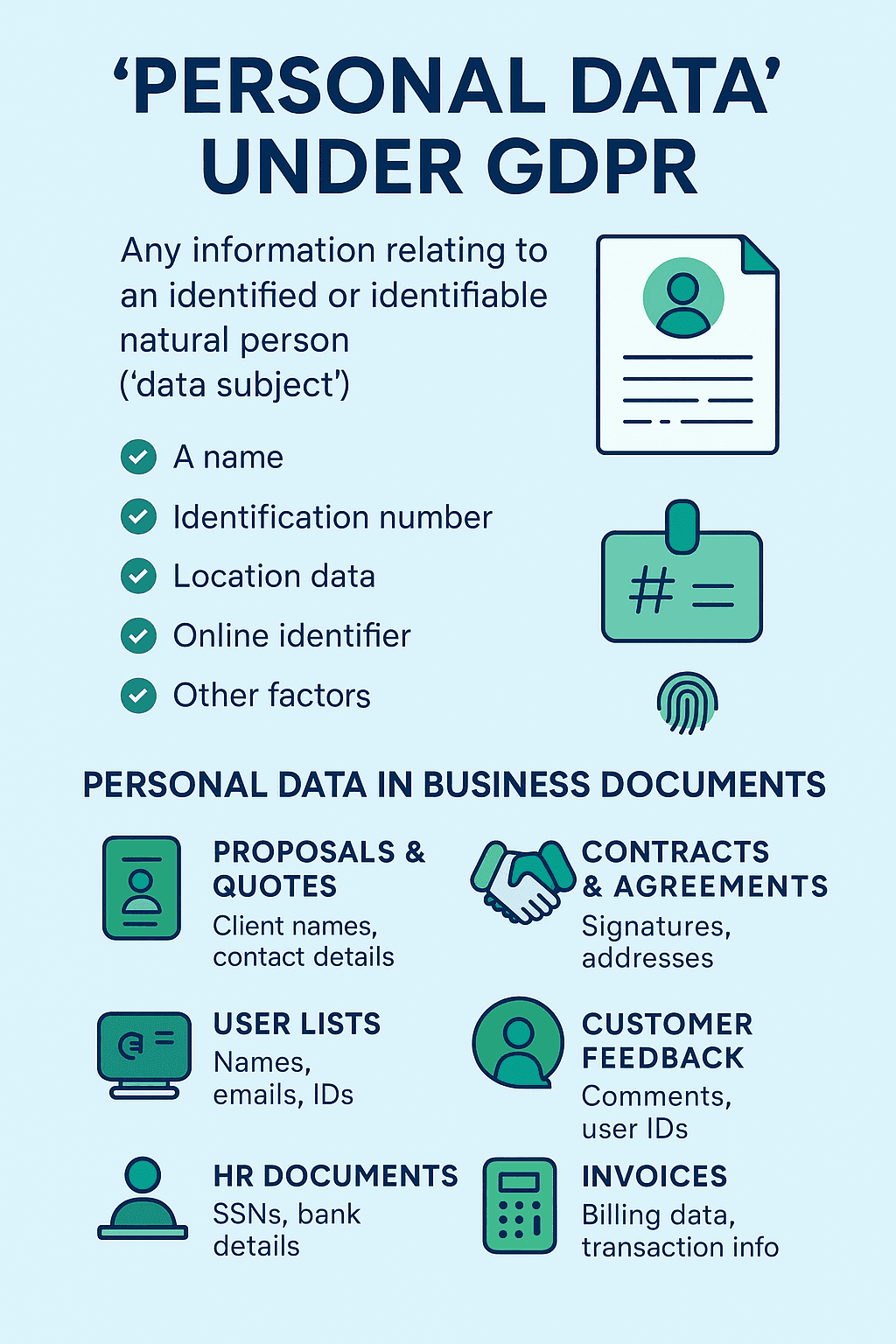What Counts as 'Personal Data' Under GDPR in Your Documents?
Introduction: Beyond the Obvious
When you think about GDPR and personal data, names and email addresses probably come to mind first. While those are definitely included, the scope of "personal data" under the General Data Protection Regulation (GDPR) is much broader, especially within the context of everyday business documents. Understanding what constitutes personal data is the critical first step towards ensuring compliance and protecting individuals' privacy.
This article will help you identify the wide range of information within common documents like proposals, contracts, user lists, and even customer feedback that qualifies as personal data under GDPR. Recognizing this data is essential before you can take steps to handle it responsibly.
What is 'Personal Data' According to GDPR?
GDPR defines personal data as any information relating to an identified or identifiable natural person ('data subject'). An identifiable natural person is one who can be identified, directly or indirectly, in particular by reference to an identifier such as:
- A name
- An identification number (like a customer ID or employee number)
- Location data
- An online identifier (like an IP address, cookie ID)
- One or more factors specific to the physical, physiological, genetic, mental, economic, cultural, or social identity of that natural person.
The key takeaway is "any information." It's deliberately broad to encompass all the ways an individual might be identified in the digital age. If you're new to GDPR, our comprehensive guide to GDPR fundamentals provides essential background knowledge.

Identifying Personal Data in Common Business Documents
Let's look at some typical business documents and the types of personal data they might contain, going beyond just names and emails:
Proposals and Quotes
- Direct Identifiers: Client names, email addresses, phone numbers, company addresses (if it identifies a sole trader).
- Indirect Identifiers: Job titles (especially in smaller companies), specific project details linked to an individual contact, unique customer reference numbers.
Contracts and Agreements (Including NDAs)
- Direct Identifiers: Names, signatures (physical or digital), addresses (personal or business), contact details of signatories and legal representatives.
- Indirect Identifiers: Bank account details for payment, specific roles or responsibilities outlined for individuals, potentially details of negotiations linked to individuals.
User Lists and Customer Databases (CRM Data)
- Direct Identifiers: Names, emails, phone numbers, addresses, user IDs, account numbers.
- Indirect Identifiers: Purchase history, service usage logs, IP addresses, device information, user preferences, support ticket history associated with a user, demographic information (age, location if specific).
Customer Feedback and Surveys
- Direct Identifiers: Name or email if collected with the feedback.
- Indirect Identifiers: Verbatim comments that might inadvertently reveal identity (e.g., mentioning a specific interaction, location, or unique issue), user IDs linked to feedback, demographic data collected alongside responses.
HR Documents (Employee Records, Applications)
- Direct Identifiers: Names, addresses, social security numbers, bank details, contact information, photos.
- Indirect Identifiers: Performance reviews, salary information, health information, disciplinary records, background check results. (Note: Employee data often has stricter handling requirements).
Invoices and Billing Records
- Direct Identifiers: Customer names, billing addresses, contact details.
- Indirect Identifiers: Transaction details linked to an identifiable customer, subscription details, payment methods (partially masked card numbers can still be personal data in context).
It's clear that personal data lurks in many places. Even seemingly innocuous details, when combined, can potentially identify an individual.
Why Identification Matters: The Responsibility of Handling Personal Data
Once you've identified that your documents contain personal data, GDPR principles kick in. You become responsible for handling that data lawfully, fairly, and transparently. This includes ensuring its security and confidentiality.
Simply emailing documents containing this identified personal data as attachments can be risky. You lose control over who sees it, forwards it, or how long it's kept. This is where the need for secure handling practices becomes crucial. Many businesses make critical mistakes when sharing documents containing personal data—learn how to avoid common GDPR document sharing errors to keep your information secure.
Using tools designed for secure document sharing helps meet these obligations. Look for solutions that offer features like:
- Encryption: Protecting data both when stored and when shared.
- Access Controls: Ensuring only authorized individuals can view the documents. This might include password protection, email verification, or limiting access by domain.
- Audit Trails: Maintaining logs of who accessed what and when, crucial for accountability.
- Expiration Dates: Aligning with the GDPR principle of storage limitation by automatically revoking access.
Furthermore, ensuring your service providers (like a document sharing platform) are also GDPR compliant is vital. Reputable providers will be transparent about their own compliance measures and security practices.
Conclusion: Identification is the First Step to Compliance
Recognizing the full extent of personal data within your business documents is fundamental to GDPR compliance. It's far more than just names and emails. By understanding this broader definition and identifying where personal data exists in your proposals, contracts, lists, and feedback forms, you can take informed steps to protect it.
Implementing secure sharing practices and using appropriate tools isn't just about avoiding fines; it's about building trust and demonstrating respect for the privacy of your clients, partners, and employees. For a deeper dive into all GDPR principles relevant to document handling, explore our guide to GDPR principles for business documents.
Ready to securely share documents containing personal data?
Papermark provides the tools you need to handle sensitive documents responsibly, featuring robust access controls, encryption, viewer analytics, and more, helping you align with GDPR principles.